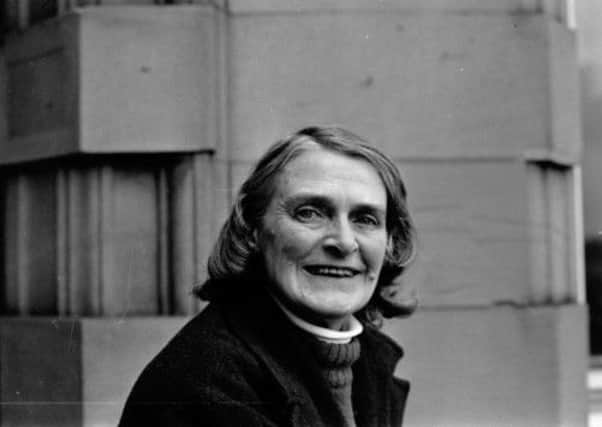Obituary: Mary Margaret Jameson Cowan, translator and campaigner


Mary Cowan, my mother, was the eldest child of John Gordon Jameson MA, MP, Sheriff and advocate, and Lucy Margaret née Smith, one of the nine children of AL Smith, the master of Balliol College, Oxford. Mary was born in 14 Moray Place, Edinburgh, which was then the residence of Andrew Jameson, Lord Ardwall, a High Court judge.
From an early age, Mary sided with the under-dog; she was always a rebel and related fights with some of the girls at St Denis’s school who had been baiting a harassed, unfortunate teacher.
Advertisement
Hide AdAdvertisement
Hide AdHer first school was St Anne’s in Manor Place, run by a spinster cousin, Marjorie Jameson, whose unusual voice Mary sometimes liked to imitate. Later, Mary had instruction from a tutor at home, Henry Johnston, and it was he who kindled her love of poetry, of the French language and literature, and encouraged her talent in drawing and painting. Mary spent a year or so at Bedgebury School in Kent and then a period at Edinburgh College of Art.
She also spent a while doing social work in Bethnal Green, London. There she was pained and disturbed to see the appalling poverty of those she was deputed to visit, with large families living in huts with only an earth floor. Undoubtedly that stimulated her lifelong desire to help the afflicted and achieve a more just society.
After her family moved to 34 Great King Street, Mary related a momentous day when she gave her pocket money to the housemaid, Agnes, to elope to London with a married man.
The Sheriff, a well-known Edinburgh eccentric, was heard shouting in Dundas Street: “Infamous daughter, aiding an act of adultery!” On the same day the cat produced a litter of kittens from the “guts of a chair”, the hotwater boiler burst and Mary met her future husband for the first time at a party.
Anthony Cowan and Mary went into professional acting for a short while, before realising Anthony’s dream of living aboard a sailing vessel. The vessel was the gunpowder Thames sailing barge, Guy Fawkes. They sailed her from the Thames up to Suffolk and lived aboard her until she was requisitioned by the War Department and reportedly sunk during bombing practice.
Mary then bought a charming Regency house in Chelsea where she and her young family spent many of the war years. One night she went to the theatre leaving a babysitter in charge. When she returned the babysitter said: “I’ve given up, I can’t get the children to settle down.” Mary went up to the nursery and found me and my elder sister commanding a battle fleet which we had drawn all over the bedroom walls. My sister had even climbed on a chest and had drawn a Spitfire on the ceiling. Possibly impressed with our creative impulses, Mary neither scolded nor punished her naughty children on that occasion.
At that time, father was away as a “sparks” in the Merchant Marine, only just avoiding getting torpedoed. One morning, Mary wondered why it was so cold as she lay in bed, and got up to find that the blast from a bomb which had fallen nearby had blown out the glass in her bedroom window.
After the war, Anthony bought his childhood home, which was a virtual ruin following neglect by troops. The old country house near Edinburgh became known in the family as Dry Rot Grange, but there Mary grew strawberries and roses which she sold to pay for my first clarinet. Mary loved traditional and classical music, and had a fine soprano voice.
Advertisement
Hide AdAdvertisement
Hide AdSoon, the family had grown to four, and when the children were off her hands, Mary was able to devote time to her philanthropic and radical interests. With the rise of fascism and the war, Mary had joined the Communist Party, and later, during the Vietnam War, she was tireless in raising money for Medical Aid for Vietnam.
Her father Johnnie Jameson had supported many humanitarian charities, and Mary continued that tradition for many years. Mary’s enthusiasm for the achievements of the Vietnamese people encouraged her to go out to Vietnam and teach English, mostly to doctors, and translate from French into English an anthology of Vietnamese poetry. This was a remarkable commitment for a lady who was then 62, and she spent a busy two years there and was much honoured by the Vietnamese.
Before Scottish devolution, Mary was honorary secretary of the Convention for Scotland in 1972 and later she made generous donations to the Campaign for a Scottish Assembly and attended many meetings on that issue. She was always much concerned with social and political problems. On her return to Scotland, Mary continued her cultivation of friends and relatives from all over the world and her globetrotting travels continued into her eighties with visits to many countries, including Cuba and Nicaragua. She also often had her children, grandchildren and great-grandchildren to stay as she loved to have the compamy and was always the most vivacious at a party.
Mary always kept a discursive diary, and her experiences in Vietnam immediately after the end of that war make interesting reading. Mary’s poems have been published in several poetry magazines, and her talented paintings continued an ability well expressed by her maternal great-grandfather, John Forster Baird.
In recent years, Mary’s interest in the teachings of Jesus revived, reflecting perhaps her father’s inspired and learned analysis of the Gospels. John Gordon Jameson’s publications included What is the Gospel?, published by the Church of Scotland in 1955.
Mary Cowan is survived by her two sons, two daughters, grandchildren and great-grandchildren.